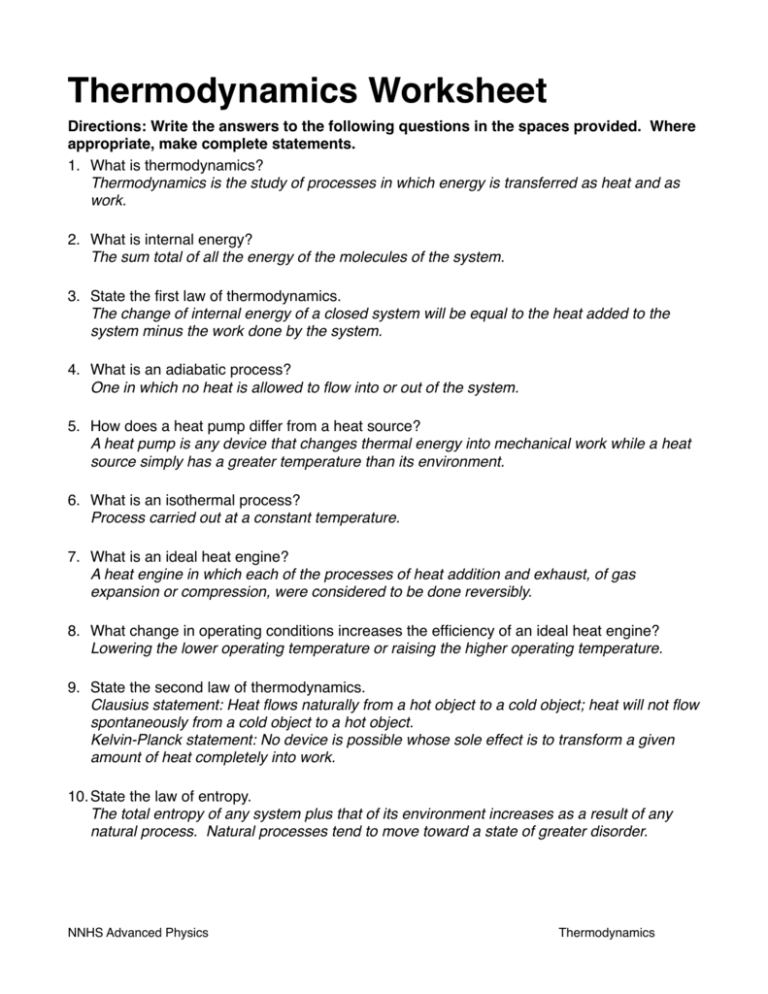Thermodynamics Worksheet: Laws, Processes, and Calculations
advertisement

Thermodynamics Worksheet Directions: Write the answers to the following questions in the spaces provided. Where appropriate, make complete statements. 1. What is thermodynamics? Thermodynamics is the study of processes in which energy is transferred as heat and as work. 2. What is internal energy? The sum total of all the energy of the molecules of the system. 3. State the first law of thermodynamics. The change of internal energy of a closed system will be equal to the heat added to the system minus the work done by the system. 4. What is an adiabatic process? One in which no heat is allowed to flow into or out of the system. 5. How does a heat pump differ from a heat source? A heat pump is any device that changes thermal energy into mechanical work while a heat source simply has a greater temperature than its environment. 6. What is an isothermal process? Process carried out at a constant temperature. 7. What is an ideal heat engine? A heat engine in which each of the processes of heat addition and exhaust, of gas expansion or compression, were considered to be done reversibly. 8. What change in operating conditions increases the efficiency of an ideal heat engine? Lowering the lower operating temperature or raising the higher operating temperature. 9. State the second law of thermodynamics. Clausius statement: Heat flows naturally from a hot object to a cold object; heat will not flow spontaneously from a cold object to a hot object. Kelvin-Planck statement: No device is possible whose sole effect is to transform a given amount of heat completely into work. 10. State the law of entropy. The total entropy of any system plus that of its environment increases as a result of any natural process. Natural processes tend to move toward a state of greater disorder. NNHS Advanced Physics! Thermodynamics 11. The mechanical equivalent of heat in the SI system is 4.186 J/cal. 4.186 J/cal 12. The first law of thermodynamics is a special case of the law of conservation of energy. conservation of energy 13. When heat is converted to another form of energy, or vice versa, there is no loss of energy. no 14. In the Joule experiment, no heat enters or leaves the insulating jar. The water-churning process is, therefore, an adiabatic one. adiabatic 15. Work done by a gas is considered positive when the gas expands and negative when the gas is compressed. expands compressed 16. When the volume of a gas increases isothermally, its pressure decreases and its temperature remains constant. decreases remains constant 17. During an isothermal expansion, the internal energy remains constant. remains constant 18. When the volume of a gas increases adiabatically, its pressure and its temperature . decreases decreases 19. During an adiabatic expansion, the internal energy . decreases 20. The source of the heat equivalent of work done by an ideal gas during isothermal expansion is its , while the source of the heat equivalent of work done by an ideal gas during adiabatic expansion is its . heat input at high temperature internal energy of the gas 21. Give an example of a heat pump: . steam engine 22. Work can be found by finding the diagram. of a area under PV curve 23. The second law of thermodynamics makes it impossible to attain a temperature of . 0K 24. Entropy is the amount of energy that cannot be converted into . useful work 25. Natural processes tend to increase universe. NNHS Advanced Physics! in the entropy Thermodynamics 26. What happens to V, P, and T in the following processes? Process Isobaric expansion V increases Isothermal compression decreases Isobaric compression decreases P T remains constant increases increases remains constant remains constant decreases During which of the above processes is work done on the gas? compression During which of the above processes is work being done by the gas? expansion 27. A gas expands from a volume of 2.00 m3 to 6.00 m3 and does 6912 joules of work against a constant outside pressure. Find the outside pressure. W = P ΔV 6912 J = P (6 m3 - 2 m3) P = 1728 N/m2 28. A Carnot engine operates between 20 °C and 500 °C. How much energy must be supplied to produce 10000 J of work? e = 1 - TL / TH = 1 - (293 K / 773 K) = 0.62 e = W / QH 0.62 = 10000J / QH QH = 16000 J 29. Find the efficiency of an ideal heat engine operating between temperatures of -100 °C and 500 °C. e = 1 - TL / TH = 1 - (173 K / 773 K) = 0.78 30. How much would the efficiency of an ideal heat engine be improved if its lower temperature were changed from 80.0 °C to 40.0 °C while the upper temperature remained at 300 °C? e = 1 - TL / TH = 1 - (353 K / 573 K) = 0.38 e = 1 - TL / TH = 1 - (313 K / 573 K) = 0.45 0.45 - 0.38 = 0.07 NNHS Advanced Physics! Thermodynamics











